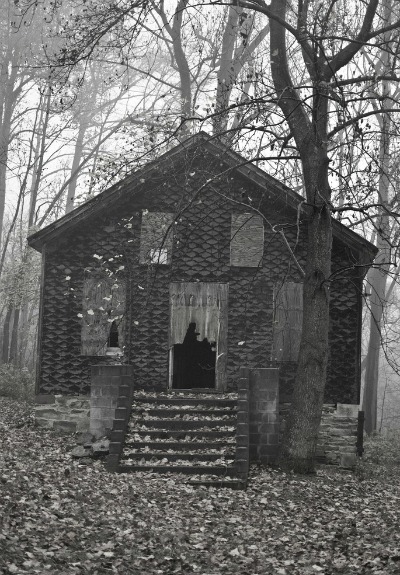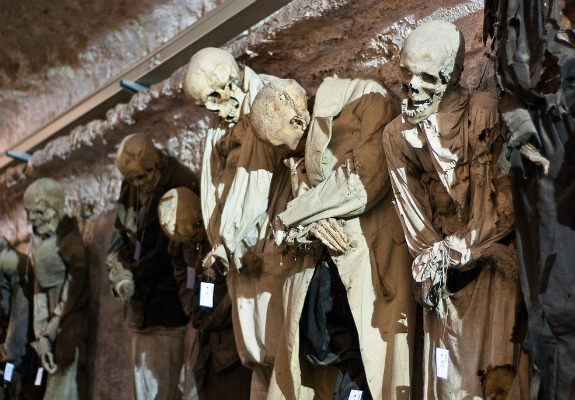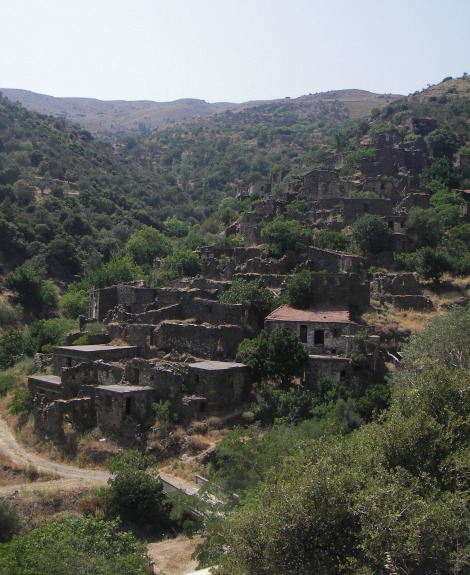The Haunted and the Haunting: Best Places to Visit on Halloween
This Halloween, indulge in the the electric, nerve-zapping thrill of fear, and consider visiting real destinations of creepy history and ghostly legends

If you were a witch, could you imagine a nicer place to dwell? This abandoned church is located in Burkittsville, Maryland, filming location of 1999′s The Blair Witch Project. Photo courtesy of Flickr user The Spider Hill.
Who can resist the thrill of fear? We imagine that hotels and churches are haunted, and we love to believe it when locals tell us that witches, werewolves and the undead lurk in the nearby woods. And though these legends and rumors often terrify us, and though our instincts tell us to run, curiosity kills the cat—and we often go tiptoeing into the tombs, graveyards and forests of our nightmares. This Halloween, indulge in the nerve-zapping thrill of being afraid, and consider visiting these real-life destinations of ghostly legends and dark history:
The Blair Witch Forest. The Blair Witch Project, that terrifying low-budget cult film of 1999, reminded millions that we may have nothing to fear in a dark and gloomy forest but our own imaginations. The movie never showed a single image of ghouls or supernatural forces, yet it scared some of us almost to death and ruined camping for the rest of the summer. The story follows three film students into the rural backwoods of Maryland to interview locals on-camera and explore the dark forests as they documented a local legend about the so-called Blair Witch. They never caught the mean old lady on film, but she began visiting them each evening after they retired to their tent, and, night by night, turned the expedition into a nightmare. The film was partially shot in the real-life town of Burkittsville. If you go, you won’t be the first, as countless film buffs and Blair Witch believers have already swarmed this little hamlet of 200. Instead of bugging the locals, who have had to replace their town sign several times in the wake of film-fan thievery, take a walk in the nearby woods after dark—and try not to panic. No—that’s not a witch in the woods behind you; worse, it’s your own imagination. Perhaps camp out in order to get the full Burkittsville experience, and before you go be sure and watch the movie.
The mummies of Guanajuato. Around 1865, the local government in the town of Guanajuato, in the mountains of central Mexico, decided to begin collecting a cemetery tax from relatives of the deceased. Bodies of families unable to pay were exhumed—and some, it turned out, had been naturally preserved in the awkward poses of death. These were placed in storage—and they became, gradually, a draw for curious visitors. So was born Guanajuato’s famed mummy museum. The assembly of the dried-out dead features more than 100 bodies displayed behind glass, where they grimace unhappily at about a million tourists per year—people with that familiar urge to see up close the feared but fascinating face of death. Visitors to Guanajuato should be warned that the mummy museum is not an attraction for the timid—or one to treat irreverently. The bodies are of real people who died only several generations ago and, in some cases, may even have been buried alive. Scientists have speculated how the bodies became mummified. Some have suggested that high mineral content in the soil preserved them, while others believe the mummies are simply the result of a warm and dry climate.

Preserved bodies of Sicilians dead for centuries line the walls of the Capuchin Catacombs beneath Palermo. These bodies have been essentially mummified; others have been treated with glycerine and remain almost as life-like as the day they died. Photo courtesy of Flickr user groucho.
The Capuchin Catacombs of Sicily. On one wall of the Capuchin Catacombs in Palermo, Italy, are deceased men, on another women, and another children. Still other chambers feature virgins, priests, monks and professionals, many preserved in varying states of life-like quality. This resting place of some 8,000 people was born in the 1500s when the cemetery serving the local Capuchin monastery ran out of bunk space, requiring the monks to dig out a new tomb to lay their dead. The chambers were originally meant to serve only friars, but the Palermo catacombs eventually expanded operations to include members of the public, whose families paid fees for the housing of their dead loved ones. Like many catacombs around the world, this communal tomb is not just a burial site but a place intended for preservation and display. The monks dried the bodies on racks, applied vinegar, glycerine and other chemical preservatives, and dressed the corpses in various styles of clothing. Fees from living families helped maintain the collection. Today, tourists may—if they wish—descend from the idyllic, sunny streets of Sicily’s chief city and go underground to meet the dead. Other catacombs of the world include those of Vienna, Granada, Melbourne, Lima and Paris. In the latter, sub-city tunnels have been filled with bones, and urban legends tell of tourists who have become lost in the maze-like corridors, which go on for hundreds of miles. The moral: Don’t ditch your tour guide.
The Hotel of The Shining. It was during Stephen King’s 1974 visit to the Stanley Hotel in Estes Park, Colorado, that the story of The Shining was born. The author, who stayed in Room 217 with his wife, reportedly saw fleeting images of children in the hallways of the mountain lodge, and these flights of imagination eventually unraveled into the story, and psychological turmoil, of his most famous book and the 1980 movie that followed. The film, however, was shot at other locations—including the Timberline Lodge near Mount Hood, Oregon, where the fictional Overlook Hotel’s exterior shots were taken. The Timberline’s hotel managers, who granted director Stanley Kubrick permission to film onsite, worried that tourists might be scared away from staying the night, so they asked that the director edit his script to make the haunted Room 217 into the nonexistent Room 237.

Alcatraz Island is said to be haunted by the ghosts of its prison days, when it housed such convicts as “Machine Gun” Kelly and Al Capone. Photo courtesy of Flickr user renedrivers.
Alcatraz Island. It was once a nest of thieves, but today, according to the legends and local lore that shroud “The Rock,” America’s most infamous historic prison is a den of ghouls. Alcatraz Island in San Francisco Bay was first documented by Europeans in 1775 when Spaniard Juan Manuel de Ayala named the 22-acre, guano-frosted outcropping “Island of the Pelicans.” In 1845 the American government bought the island, which would serve as a cannon-studded fort and a military prison. Then, in 1934, the convicts came to stay, and for the next three decades the worst of America’s murderers and gangsters paid their dues and, sometimes, died here. One prisoner was supposedly found strangled to death in isolation cell 14D, and it is said that moans and cries still echo from the chamber. And though Al Capone died at his Florida mansion, his ghost is said to haunt the prison where he spent four and a half years. Capone reportedly took up the banjo at Alcatraz, and off-key twangs are sometimes heard today, according to employees and park rangers at what has become a national historic monument. Tourists may visit the island for self-guided daytime tours, while evening walks through the jail require a guide, who is sure to be well-versed in ghost stories of Alcatraz Island.
The Abandoned Villages of Chios. Guided ghost walks show visitors through the haunted districts of many cities, including New Orleans, Philadelphia and London, but for a ghost experience completely off the charted tourist path, go straight to the Greek island of Chios. Here, blue waters and tavernas on the beach draw crowds of sun-seeking Germans and Britons—but a darker history seems to lurk in Chios’ remote mountains. For as the island develops into a summer and fall tourist hotspot, it has left behind numerous villages, where abandoned homes stare from the dry slopes like so many skulls half buried in the earth. Anavatos is the most famous vacant village—and now a national historic site. And a number of empty villages seem to have no names at all—and good luck finding them. But Potamia in the island’s northeast is among the few abandoned towns that remain on the maps. A cluster of decaying old homes with broken out windows, like eye sockets, and crumbling doorways, Potamia is accessible by goat trails and can be reached by hikers and bikers with a hankering for the rare and stomach-fluttering feeling of exploring a whole town with not a soul—or at least not a person—in it. Walking through the slumping dirt streets, one may wonder where once was the bakery, the butcher, the school, and the chapel. You don’t believe it’s haunted? Neither did I when I visited several years ago—but try camping alone here on a full moon, and see if you don’t leave in the morning howling a different tune.

The village of Potamia, on the Greek island of Chios, stares from the canyonside like a wall embedded with skulls. Though not generally known as a haunted town, Potamia may seem to come alive with ghosts for those who camp here alone. Photo by Alastair Bland.
For further reading, check out Smithsonian‘s list of “Real Places Behind Famously Frightening Stories.” Of note are the castles that inspired Bram Stoker’s Dracula, the Sleepy Hollow cemetery and the steep, low-lit stairway featured in The Exorcist.
/https://tf-cmsv2-smithsonianmag-media.s3.amazonaws.com/accounts/headshot/Off-Road-alastair-bland-240.jpg)
/https://tf-cmsv2-smithsonianmag-media.s3.amazonaws.com/accounts/headshot/Off-Road-alastair-bland-240.jpg)